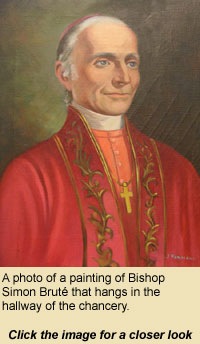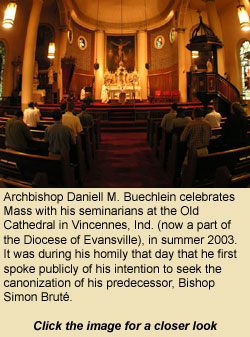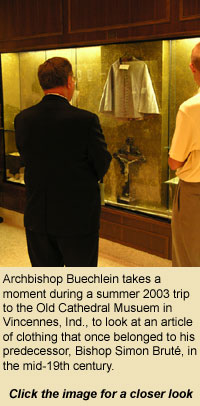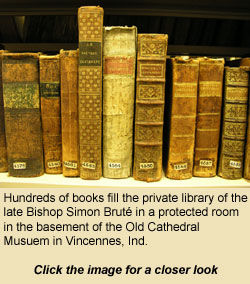Cause for canonization of Bishop Bruté
closer to official opening
Postulator in Rome has been hired
By Brandon A. Evans
 Less than a century after his death in 1839, Bishop Simon Bruté was already being hailed as a saint.
Less than a century after his death in 1839, Bishop Simon Bruté was already being hailed as a saint.
Father Bruté, after a long career of educating future priests and serving as the spiritual director of St. Elizabeth Ann Seton, was called by his fellow bishops and Pope Gregory XVI to be the founding bishop of the newly formed Diocese of Vincennes in 1834.
Though he only lived for another five years, his labors laid the foundation for Catholicism to flourish in Indiana and eastern Illinois.
In 1891, Cardinal James Gibbons said the following: “Worthy citizens of Vincennes, you need not go on pilgrimages to visit the tombs of the saints. There is one reposing here in your midst, namely, the saintly founder of this diocese, Right Reverend Simon Bruté.”
Now, after the passing of another century, and after the Diocese of Vincennes was splintered and became the Archdio-cese of Indianapolis, the successor to Bishop Bruté is seeking to have him canonized.
Archbishop Daniel M. Buechlein is setting in place the necessary steps to open an official cause for canonization of the late bishop.
The first steps include consulting the bishops of Indiana, Illinois, Michigan and Wisconsin, and consulting the various congregations of the Vatican.
If no objections are received, a Nihil Obstat (“nothing stands in the way”) is granted and an official cause could be opened by this fall—and Bishop Bruté would be given the title “Servant of God.”
From there, officials and committees would examine every writing of Bruté’s and all that is known about him to prove that he lived a life of heroic virtue.
 At that point, he would be known as “venerable,” and the cause would move on to the next phase in the canonization process—looking for two miracles that can be attributed to the heavenly intervention of Bishop Bruté.
At that point, he would be known as “venerable,” and the cause would move on to the next phase in the canonization process—looking for two miracles that can be attributed to the heavenly intervention of Bishop Bruté.
But before any of this, the first thing that Archbishop Buechlein had to do was find a postulator for the cause—the person who will advocate on behalf of the cause.
He selected Andrea Ambrosi, a lawyer, and had him send a copy of a biography on Bishop Bruté written by the late Benedictine Sister Mary Salesia Godecker. Ambrosi is currently also serving on the cause of Blessed Mother Theodore Guérin and Archbishop Fulton Sheen.
“I was very impressed with the figure of Bishop Bruté,” Ambrosi said. “I think he is a wonderful example for us today because he gave proof of human and moral qualities not common.
“He was never intimidated or discouraged during his difficult life, and he never had the need for rest. He was always enthusiastic and had a fervent zeal in spreading out the word of God in his diocese.”
In his later years, Bishop Bruté spent agonizing days traveling on horseback to the scattered outposts of Catholicism in his vast diocese where people were hungry for the faith.
He often wrote with passion on the role of those in his time in preparing the United States to be a place where the Catholic Church could grow.
Upon seeing such potential or such failure, he wrote that failure would surely result “unless the occasion and crisis, the only chance and moment, now, be not improved to the very best; for there can be no too great liberty of best choices.”
In his missionary zeal, Bishop Bruté was sometimes frustrated by his own limits—the German language being one of them.
 “I cannot express the great sorrow I experienced when, on visiting the Jasper [Ind.] Mission, I celebrated the Sacred Mysteries in the presence of a great number of German Catholics but was unable to impart to them the saving words of our holy religion,” the bishop wrote. “After Holy Mass, I wept bitter tears, raised my hands to heaven and told my sorrow to my God.
“I cannot express the great sorrow I experienced when, on visiting the Jasper [Ind.] Mission, I celebrated the Sacred Mysteries in the presence of a great number of German Catholics but was unable to impart to them the saving words of our holy religion,” the bishop wrote. “After Holy Mass, I wept bitter tears, raised my hands to heaven and told my sorrow to my God.
“But greater was my grief when I saw several of the people shed tears because [as those who spoke English informed me] there was no one to break the Bread of Salvation for them.”
At the start of his episcopal ministry, the late bishop had only two priests to cover the expanse of his diocese, and it was a constant struggle to find well-suited men to help him in the ordained ministry.
“I compared Bishop Bruté’s life to ones of other saints and decided that we should try to bring this bishop to the altars,” Ambrosi said, referring to the official inclusion of saints in the liturgy.
His is an admiration of the bishop that Archbishop Buechlein shares and can trace back to his days as a seminarian.
“With some seminary friends, I visited the Old Cathedral [in Vincennes] and was intrigued by our early roots and the courage and zeal of our first bishop,” Archbishop Buechlein said. “He was able to do so much with so little by way of human and financial resources in such a brief time as bishop.
“Later, I became more aware of his personal holiness.
“The apostolic zeal, humility, simplicity, determination, courage and confidence in God’s will make Bishop Bruté a splendid model for all Catholics of our day,” Archbishop Buechlein said. “He is a relevant model for all who are involved in furthering the Church’s ministry today.
“He was arguably the most influential theologian of the Church in the United States in his day.”
The archbishop said he believes that any human limitations and weakness that Bishop Bruté had are eclipsed by his holiness and zeal.
Msgr. Frederick Easton, vicar of the vicariate judicial for the archdiocese, said that Bishop Bruté shows us that holiness is not some distant concept, but is close to home.
“That’s where the holiness is,” he said. “It’s the spirit with which you do ordinary things.”
 While Archbishop Buechlein said he would be happy to see the future cause come to completion while he is still archbishop of Indianapolis, he added that, “I will have felt I did my duty by simply launching the investigative process. The rest is up to God and our first bishop.”
While Archbishop Buechlein said he would be happy to see the future cause come to completion while he is still archbishop of Indianapolis, he added that, “I will have felt I did my duty by simply launching the investigative process. The rest is up to God and our first bishop.”
The archbishop recently named a new house of formation for seminarians at Marian College in Indianapolis in honor of his predecessor. That is one way of building a public knowledge of Bishop Bruté and honoring him that is permissible at this point.
“Public devotion can occur only after beatification and in a local way,” Ambrosi said. “Public devotion in the whole world can occur only after canonization. Now we can devote [ourselves to] him in a private way, which means that we can go to his tomb and say a prayer.”
As for the timeline, he said, it could be a few years for the Vatican’s Congregation of the Causes of Saints to process the positio on Bishop Bruté to determine if he is “venerable.”
He added that if a miracle is submitted early on in the process, the cause will proceed more quickly.
“It’s not in our control,” Msgr. Easton said. “That’s where the mind of faith comes in. This is God’s deal here.”
As for the cost of opening and pursuing the cause for Bishop Bruté, it will probably be around $250,000, but it could be as much as $1 million, Msgr. Easton said.
But there again, he added, we rely on Providence and the generosity of Catholics to contribute to the canonization effort financially.
Ambrosi said that there are few causes in process for the canonization of bishops.
“I would like to ask everybody to pray for the American Church,” he said, “and especially now for the Archdiocese of Indianapolis because it would be a great honor for them to have their first bishop canonized.” †



